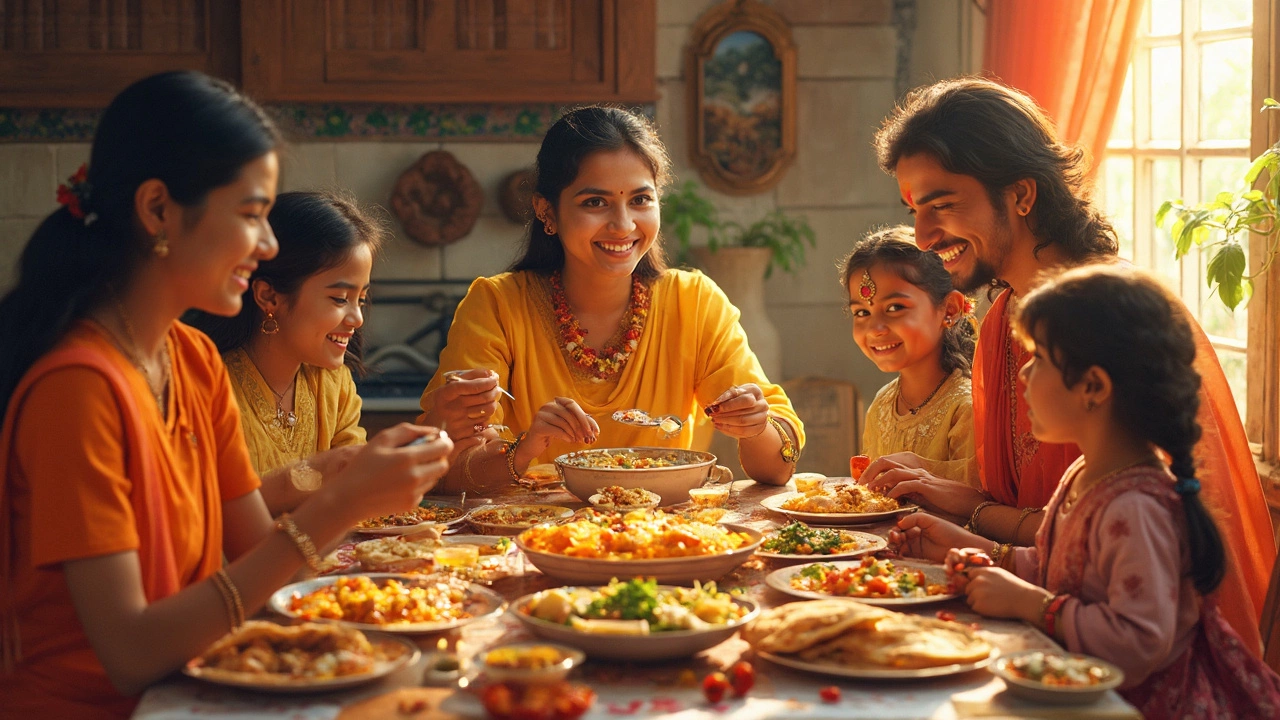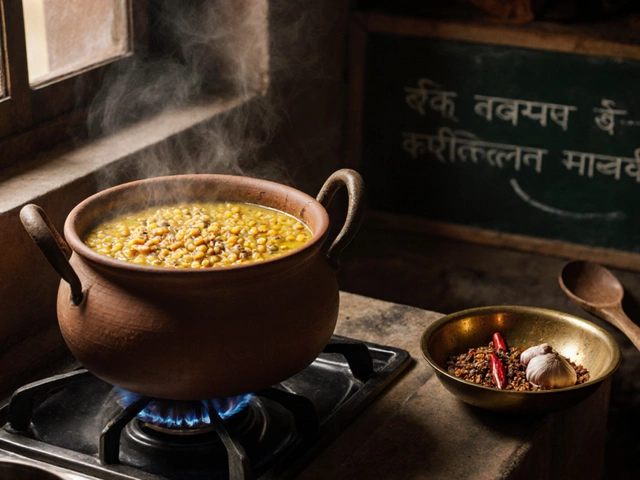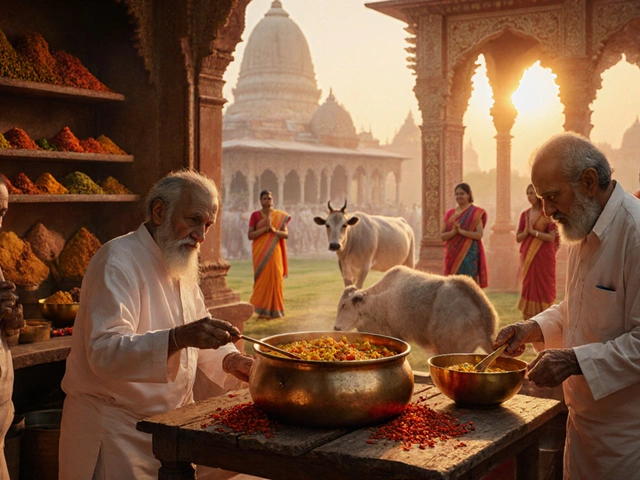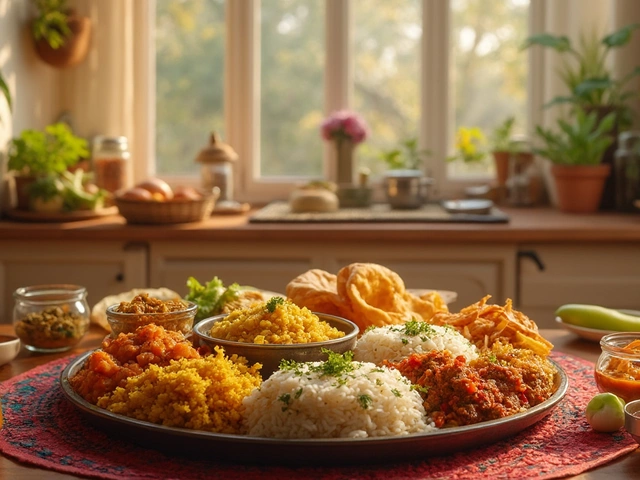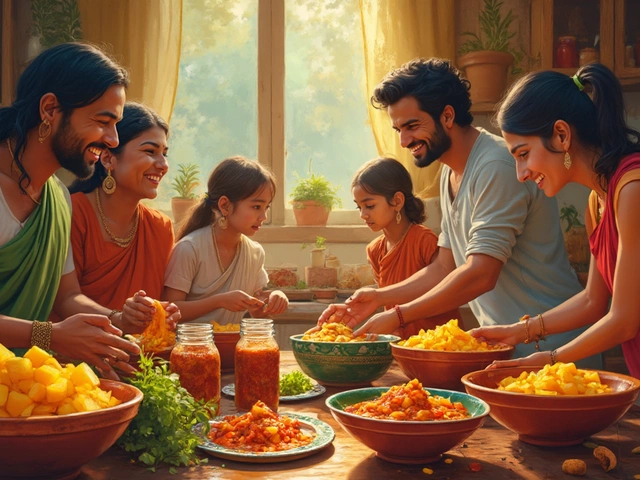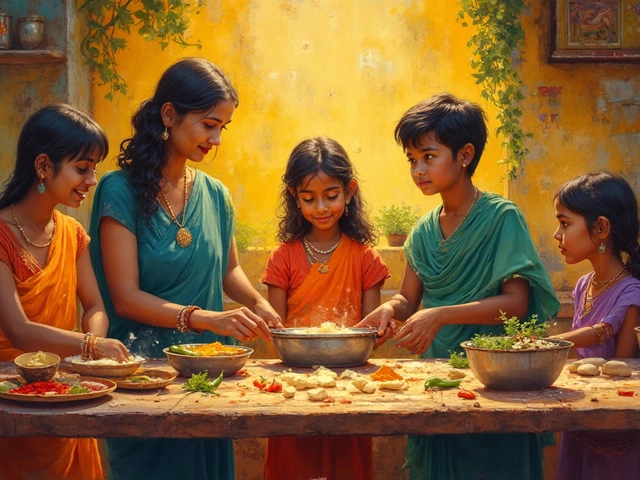Ever wonder why so many Indian dishes skip meat and focus on veggies, lentils, and grains? If you peek inside an Indian home kitchen, there’s a good chance you’ll see bubbling pots of dal, fragrant sabzis, and a stack of warm rotis ready to go. Meat shows up here and there, but it’s totally outnumbered by veggie-based meals.
India stands out in the world this way. Most countries fill plates with chicken, pork, or beef, but in India, a giant chunk of the population—almost 40% if you believe the latest government surveys—sticks to a vegetarian or mostly vegetarian diet. That’s millions of people choosing chana masala or paneer tikka over a burger. Sounds a bit odd at first, right?
This style isn’t just about taste or tradition. It’s tied to religion, culture, history, and even some pretty up-to-date research about health and the environment. If you’re looking for new kitchen ideas or just want to understand what makes Indian food tick, knowing why meat takes a back seat might change how you see the whole cuisine.
- History of Indian Food Habits
- Religion’s Big Role in Vegetarianism
- Health and Environment Reasons
- Hidden Surprises: Where Meat is Popular
- Everyday Veggie Dishes and How to Try Them
History of Indian Food Habits
India’s mostly vegetarian food scene didn’t pop up overnight—it’s got roots going back thousands of years. Way back in ancient times, people living along the Indus Valley (over 4,000 years ago!) relied a lot on grains, beans, and seasonal veggies. No surprise there, really, because crops like wheat, barley, and lentils were easy to grow. Fast forward a few centuries, and you see records from the Mauryan Empire (about 300 BCE) showing that ruling families took pride in plant-based meals, and even promoted animal protection.
A big turning point came with religious ideas. When Buddhism and Jainism started trending (yes, even ancient India had trends), followers gave up meat to avoid harming living things. These teachings stuck, and over generations, whole communities changed what landed on their dinner tables—animal-based foods took a back seat to lentils, rice, and vegetables.
Even historical texts like the “Manusmriti” (an ancient book of laws) label meat-eating as less pure than vegetarian meals. Royals and regular families alike saw eating plant-based as a sign of self-control and higher values.
So, when you see a spread of Indian vegetarian dishes today, you’re looking at habits steeped in old-school values and smart farming. Supply also played a role—meat was often pricey or not easy to get, especially during tough times or droughts, so most families just worked wonders with local produce.
| Ancient Food Staples | Main Uses |
|---|---|
| Wheat & Barley | Breads, porridge, basic meals |
| Lentils & Pulses | Protein for daily diets |
| Rice | Main grain in eastern and southern India |
| Vegetables (like eggplant, okra) | Curries, stir-fries, sides |
No matter where you travel in India now, these food basics still show up, mixed with lots of local flavor. Think about this next time you taste rajma (kidney bean curry) or aloo gobi—these meals have come a long way, but the roots are ancient.
Religion’s Big Role in Vegetarianism
If you ask anyone in India why veggies rule the plate, religious beliefs come up fast. Three main faiths—Hinduism, Jainism, and Buddhism—have shaped the country’s eating habits in a big way. Around 80% of Indians call themselves Hindu, and for a lot of Hindus, not eating beef is a hard rule. Cows are considered sacred, so beef is usually out of the question. Many also skip all kinds of meat or even eggs, especially on certain days or during festivals.
Now, Jainism takes things up a notch. Jains are strict vegetarians—most won’t even eat root veggies like garlic and onions, trying to keep from harming tiny life forms in the soil. It’s about non-violence, or “ahimsa.” That’s why pretty much every Indian vegetarian dish in a Jain restaurant is ultra-simple but super tasty.
Buddhists in India have varied diets, but in some communities, avoiding meat is still a sign of respect for all living beings. And Sikhs? Some eat meat, but many don’t, especially across northern India. Even if they do, they tend to shun beef and stick to chicken or fish.
If you look at the numbers, they say a lot:
| Religion | Common Diet Practices |
|---|---|
| Hinduism | Most avoid beef, many avoid all meat |
| Jainism | No meat, no roots, strict vegetarian |
| Buddhism | Mostly vegetarian in practice |
| Sikhism | Mix of vegetarian and limited meat |
It all adds up to a food culture where India vegetarian meals aren’t just a health hack—they’re a way to live your values. You’ll spot special rules even at fast food chains. Ever see a separate vegetarian counter at a McDonald’s in Mumbai? That’s because of these strong customs. Even wedding buffets have huge vegetarian spreads, while meat is sometimes stuck on a corner table, just to keep everyone happy.
The cool thing? These religious food choices are so normal that even folks who eat meat usually end up loving and sharing Indian vegetarian dishes with friends and family. It’s a lifestyle, not just a diet trend.
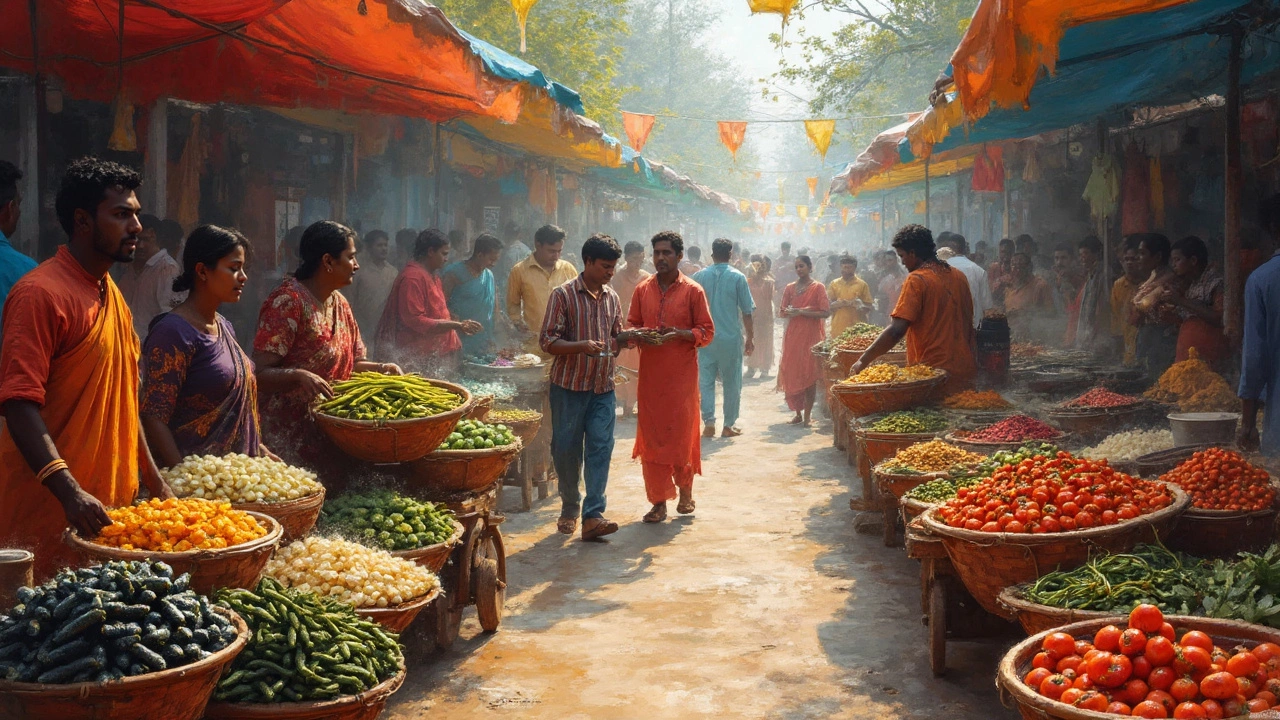
Health and Environment Reasons
So, why are Indian vegetarian dishes such a big deal beyond just culture and faith? Part of the answer is health. Doctors in India and around the world often say eating more veggies, beans, and grains is linked with lower risks of heart problems, diabetes, and certain cancers. That doesn’t mean every veg meal is healthy (hello, deep-fried samosas), but on average, skipping lots of meat, especially red meat, can help you dodge a few illnesses.
What’s pretty interesting is how the typical Indian meal lines up with modern nutrition tips: lots of fiber, not much saturated fat, and a solid amount of protein from lentils, chickpeas, paneer, and nuts. Back in 2017, a study by the Indian Council of Medical Research pointed out that rates of heart disease and obesity were lower in mostly vegetarian regions compared to places where folks eat more meat, like Kerala or Goa.
It’s not just about personal health, though. Many Indian families stick with veggie food because it’s cheaper and goes further. Lentils and rice can feed a big crew for less cash than chicken or lamb, especially with daily meals.
The environment also plays a part. Raising livestock takes lots of water and land and creates more pollution than growing crops. In fact, Indian vegetarian eating habits actually save resources—on average, it takes less than half the water to produce a kilo of lentils compared to a kilo of beef. Here’s a snapshot from a 2022 government report:
| Food Item | Water Needed per Kilo |
|---|---|
| Beef | 15,400 liters |
| Chicken | 4,300 liters |
| Lentils | 4,000 liters |
| Wheat | 1,800 liters |
With a growing population and less farmland, it makes sense for many in India to lean on plant-based foods instead of upping meat consumption. So when you’re digging into that big bowl of dal or tucking into a spicy potato curry, you’re actually part of a bigger health and environmental story that’s been going on for generations.
Hidden Surprises: Where Meat is Popular
Here’s the twist—while lots of people think of India vegetarian food first, there are plenty of places where meat is on the menu way more than you’d expect. If you travel east, you’ll run into big meat-eating habits in states like West Bengal, Assam, Nagaland, and most of the Northeast. Fish, chicken, and pork are kitchen staples there, and beef isn’t taboo like in the north. In Kerala and Goa, folks love seafood and spicy pork curries, thanks to coastal traditions and Portuguese influence.
Down south, in cities like Hyderabad, biryani with juicy chunks of mutton or chicken is practically a food group. And in Punjab, butter chicken and tandoori meats headline every celebration. Even though Indian food culture is famous for veggie dishes, you’ll easily spot meat feasts in these regions.
| Indian State | Meat Preference | Main Types of Meat |
|---|---|---|
| West Bengal | Very Popular | Fish, Chicken, Mutton |
| Kerala | Highly Common | Fish, Beef, Pork |
| Nagaland | Extremely Popular | Pork, Chicken, Beef |
| Hyderabad (Telangana) | Well Known | Mutton, Chicken |
| Punjab | Popular at Festivals | Chicken, Mutton |
If you’re looking to try real-deal regional Indian food culture, branch out and try Assamese pork curry, Goan fish recheado, or a Bengali prawn malai curry. There’s a whole side of India that loves meat—sometimes as much as veggies—especially during festivals, family dinners, and street food nights.
But here’s a tip: meat habits depend a lot on local history, climate, and what’s affordable. In the Himalayas where veggies can be hard to grow, locals have always relied on dried meat and fish to survive wintry months. So, if you visit a new state, don’t be shocked to see chicken tikka sitting next to paneer or fish heads in a curry pot. India’s food map is wilder and more mixed than most people realize.
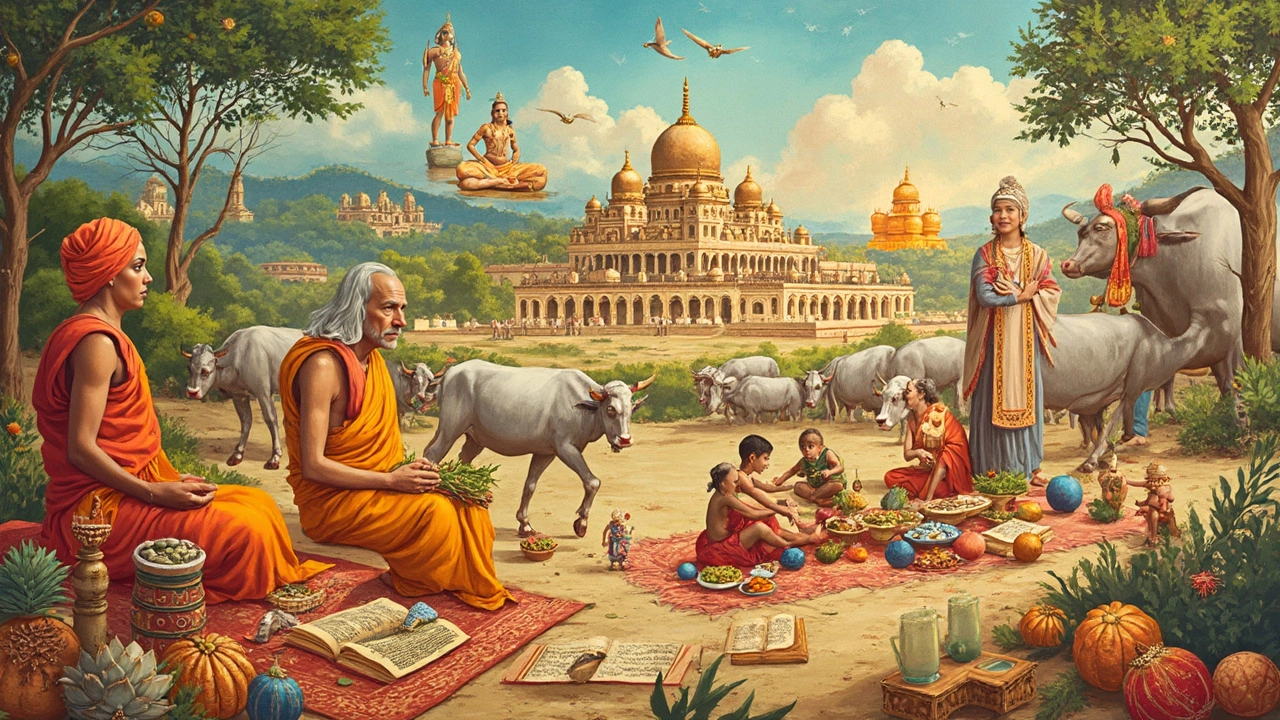
Everyday Veggie Dishes and How to Try Them
If you peek into an Indian kitchen, you’ll spot more veggie meals than you can count. It’s not just about salads or bland healthy food—the real magic comes from all the spices, pulses, and easy tricks passed down over generations. Ready to shake up your dinner routine? Indian vegetarian dishes are actually pretty doable, even if you’re new to cooking.
Let’s talk about what Indian families regularly eat. Most homes, north or south, go for dal (lentil stew) almost daily. Some keep their dal simple with just turmeric and salt, others jazz it up with onions, ginger, and cumin seeds. Pair that with sabzi—a quick veggie stir-fry or curry using anything from cauliflower to eggplant—and a side of warm roti or rice.
- Dal Tadka: This staple’s made from yellow or red lentils, cooked until soft, then topped with a spicy oil called tadka (think garlic, chili, and cumin splattered into hot ghee). Super filling and packed with protein.
- Aloo Gobi: Potato and cauliflower, cooked with turmeric, garam masala, and tomatoes. It’s classic, easy, and goes with anything.
- Chana Masala: A chickpea curry that’s tangy and a little spicy, usually eaten with rice or flatbread. Canned chickpeas work fine if you’re short on time.
- Palak Paneer: Creamy spinach sauce with cubes of paneer cheese. You can swap tofu if you want to make it vegan.
- Bhindi Masala: Okra (or ladyfinger, as they call it in India) sautéed with onions, tomatoes, and dry spices. It’s quick and doesn’t get slimy if you use enough heat.
Notice a pattern? Most Indian vegetarian food relies on inexpensive pantry basics: lentils, beans, seasonal veggies, and lots of spices. According to the National Sample Survey, almost 75% of Indian households eat at least one kind of dal every single day—it’s just that essential. If you’re worried about protein, don’t be. Indian dals, beans, and paneer pack plenty of it. Check this out:
| Dish | Main Ingredient | Approx. Protein per Serving |
|---|---|---|
| Dal Tadka | Lentils | 9g |
| Chana Masala | Chickpeas | 11g |
| Palak Paneer | Paneer | 14g |
If you want to give a simple Indian vegetarian meal a shot, start small. Here’s a quick way to try dal and sabzi together:
- Buy a bag of red lentils (they cook fast) and any vegetable you like (carrots, peas, potatoes, or frozen veggie mix works too).
- Cook the lentils in water with turmeric and salt until soft.
- Meanwhile, chop up your veggies and fry them in a pan with onion, garlic, and any curry powder or spice mix you have.
- Finish the dal with a little fried cumin and garlic (just heat oil, toss in spices, then pour over the dal for extra flavor).
- Eat with rice, naan, or tortillas. That’s legit how real families put dinner on the table.
You don’t need fancy gear or hard-to-find ingredients. My kids, Jasper and Leona, actually like dal with plain rice as long as I let them add yogurt on top. Even our dog Milo drools when he smells the spices—though, let’s be honest, he’ll eat anything. Give it a shot and you’ll see why these Indian food culture habits are so easy to fall in love with.





